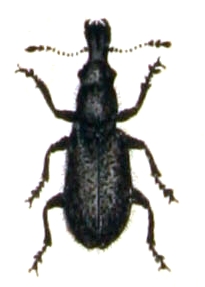Nemonyx lepturoides
| Nemonyx lepturoides | ||||||||||||
|---|---|---|---|---|---|---|---|---|---|---|---|---|

Nemonyx lepturoides |
||||||||||||
| Systematics | ||||||||||||
|
||||||||||||
| Scientific name | ||||||||||||
| Nemonyx lepturoides | ||||||||||||
| ( Fabricius , 1801) |
Nemonyx lepturoides is a species of weevil from the family Nemonychidae and the superfamily Curculionoidea .
features
The species has a body length of about four to six millimeters. It is, including all body appendages, black in color and slightly shiny. Striking is the upright white hairs of the entire body, in which slightly longer dark hairs are scattered sparsely. The trunk (rostrum) is short and straight, shorter than the pronotum . It is slightly angled opposite the contour of the head. It is somewhat widened towards the tip and has a flat, horseshoe-shaped depression here. The straight antennae are turned a little in front of the middle of the trunk, they are elongated with a clearly separated, three-part club. On the head there are strikingly large, hemispherical, bulging complex eyes . The pronotum is rounded on the sides and significantly narrower than the elytra . These are elongated, almost parallel-sided, slightly narrowed backwards, they are widest at the base. They have indistinct longitudinal ribs on the upper side and indistinct row points. The legs have toothed claws. The differences in body shape between males and females are small. The female can be recognized by two bristle fields on the sides of the fifth abdominal star.
larva
The larva is about six millimeters long, the head capsule one millimeter wide. They are pale yellow in color with a yellow-brown, unmarked head. The three-segment legs with a claw at the end are striking on the thorax , such leg formation is limited to the genus Nemonyx in the weevils , usually the larvae in the superfamily are legless, in some other genera there are undivided or at most two-segment leg rudiments. The head capsule has two short, single-segment antennae. Larval eyes (stemmata) do not occur in this species. The body of the larva is quite uniformly divided into ringlets (plicae). On the head capsule, the clypeus and frons are fused together without a seam. The frons is extended forward into a formation called pseudoclypeus.
Way of life
The larva of Nemonyx lepuroides develops exclusively ( monophag ) inside the ovary in flowers of the field delphinium ( Consolida regalis ) and some closely related species, which today are mostly only considered subspecies of this species. The adults are observed in this way in June and July. They eat pollen, biting open the anthers quite destructively, and they also gnaw on the spur to get to the nectar. The eggs are laid on the developing seed pod. The larvae feed on the ovules. They take around two to three weeks to develop - the time the seeds would otherwise have matured. When the capsule opens to scatter the seeds, the larva drops to the ground. It then digs an oval pupa chamber in the ground, where it hibernates as an old larva (or “prepupa”) ready to pupate. There seems to be only one generation a year.
The species of the genus Nemonyx are the only known Nemonychidae whose larva does not feed on pollen.
distribution
The species inhabits an area from France across Central Europe and the Mediterranean to Asia Minor and the Caucasus. In the Mediterranean region, in Africa north of the Sahara, there are two related species. The northern limit of distribution lies in Germany and Poland, the species is absent in Scandinavia and Great Britain.
The nutrient plant delphinium is a type of low-nitrogen calcareous field, it is also found on open roadsides and occasionally in rough grasslands . In Central Europe it is threatened by the intensification of agriculture and is on the Red List of Endangered Species in Germany with the category “endangered” . Nemonyx lepturoides , which used to be widespread in Germany but was never common, is now acutely threatened with extinction in Germany. In Baden-Württemberg, the last record comes from 1992 (in Kraichgau), in the meantime the species has probably died out here. In Bavaria, it is considered to be critically endangered. In Saxony-Anhalt, where most of the finds were made in the past, things don't look any better.
swell
- Brenda Μ. May (1993): Larvae of Curculionoidea (Insecta: Coleoptera): a systematic overview . In: Lincoln, NZ (editor): Fauna of New Zealand , No. 28. Manaaki Whenua Press.
- Lothar Dieckmann (1974): Contributions to the insect fauna of the GDR: Coleoptera- Curculionidae (Rhinomacerinae, Rhynchitinae, Attelabinae, Apoderinae) . Contributions to entomology: Contributions to the insect fauna of the GDR Vol. 24: 5–54, doi : 10.21248 / contrib.entomol.24.1-4.5-54 .
- Hans Gonget: The Nemonychidae, Anthribidae and Attelabidae (Coleoptera) of Northern Europe . Fauna Entomologica Scandinavica, Vol. 38. Brill Academic Publishers (Leiden).
- Joachim Rheinheimer & Michael Hassler (2010): The weevils of Baden-Württemberg . Publishing house regional culture. ISBN 978-3-89735-608-5 .